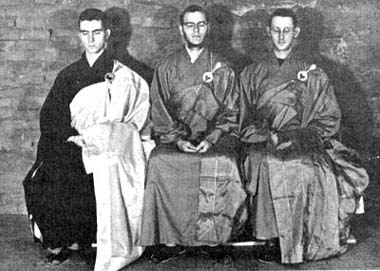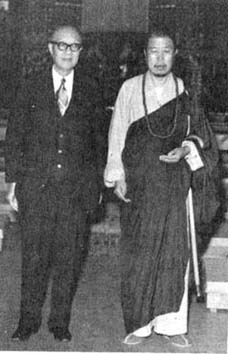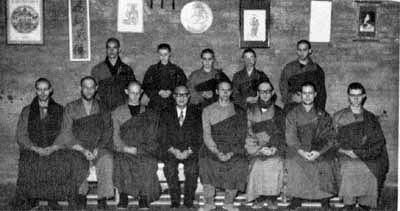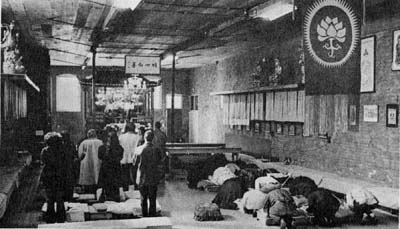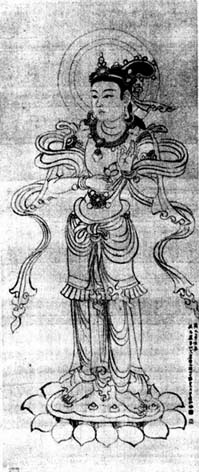|
At the reception, attended by more that three thousand eminent guests
from all over the world, it was obvious that the viewers were dazzled by the
genius of the works. The Sangha of Gold Mountain was pleased to receive an
invitation to see the paintings, and honor one who has done so much for the
cause of propagating the right Dharma.
--By
Bhiksu Heng Kuan
Letters Received.
Dear
Secretary,
Please
accept my obeisances. I recently read your article in the March "Maha
Bodhi" and was simultaneously surprised and excited. I have recently been
attempting to contact parties in Thailand and Hong Kong for information
concerning Sangha ordination for women. I might add, these attempts have proved
almost fruitless. Needless to say, I found the "Gold Mountain Temple"
article very interesting.
Yours
in the Dharma of Lord Buddha,
Barbara Ventressa
Library
The library at Gold Mountain Monastery is nearing completion. When the
cataloguing is finished the library will be an excellent research facility for
Buddhist Studies and related areas. Although The Sino-American Buddhist
Association has received many generous donations of books, additions are always
welcome. In spite of the emphasis on Buddhism and related areas, books on all
subjects, and in any language, will help make the library a useful tool for
students. Your donations will be greatly appreciated.
The Professor Requests A Lecture
A series containing the texts of speeches given at
the
Jones Gulch Dharma Assembly which was arranged by Professor Lancaster of UC
Berkeley in November 1971. Continued from issue thirty-one.
Dharma
Master Heng Shoou spoke of becoming a Buddha, which is no piece of cake I can
tell you, having just begun myself; it is very difficult. Once you are a Buddha
I guess everything is very easy. He also spoke of the accouterments that many
people think go along with Buddhism which are really superfluous. What is really
important are the precepts, the sastras and the sutras.
The
very beginning of Buddhism lies in the precepts. A beginning cultivator must
always receive and study the precepts for a long time before he can emit light
and have food brought to him by the gods everyday. A lot of people may think
that they would rather not put so much effort into morality, not realizing that
it is necessary for achieving and maintaining higher states. So I thought I'd
tell a story to illustrate what the precepts can do. They are not just for achieving bizarre states but are also a way of
protecting yourself, from yourself and from your desires.
One
day when Sakyamuni Buddha was walking along the road with some of his disciples,
he passed a cornfield and asked his disciples what they thought the field was
for. They didn't know and asked him to explain. He said, "This corn was
grown by hunters. As soon as the corn becomes ripe the hunters pull down the
fence, and from the surrounding countryside deer rush in, only to be caught by
the hunters."
Then
the Buddha asked his disciples if they could think of a way that the deer could
get at the corn without being caught. When they couldn't come up with an idea he
suggested that perhaps the deer could come from a long way away, and sweep in
and out of the corn field a lot faster, and perhaps the hunters would not be
able to capture them. His disciples thought that that would not do, for even if
they came from a long way away, as soon as they swept into the cornfield they
would be easy game for hunters.
So
the Buddha asked again, and suggested that perhaps the deer might just poach a
bit, and instead of being sucked in by the hunters, might just take it easy and
sort of nibble at the corn, just come in and take a little bit and run out
again. The disciples all agreed that this method would work.
The
point of the story is that though everybody needs to eat, eating needs to be
done with discretion. You should he careful or you will become game for the
hunters, and your own desires will trap you just as the deer were trapped. If
you learn to regulate your desires, and keep them under control, you will be
able to survive. Now it could be said that the deer that succeeded just kept one
precept, "take it easy when looting cornfields."
Precepts
are the beginning of cultivation. They make it possible for you to regulate your
life and protect you from yourself while you learn to attain the higher states,
like emitting light, becoming a Bodhisattva, and being fed by the gods. Because
precepts are the beginning, they must be the beginning of Buddhism in this
country. You can decide to hold only one precept if you wish, depending on how
vigorously you wish to cultivate, how thoroughly you wish to regulate yourself,
and what states you wish to obtain. Precepts
can take you from the cornfield right up to Buddhahood. Everybody has the Buddha
nature, but it is necessary to bring it out; it just doesn't come by itself. The
Buddha-nature is independent of desire and so precepts are the very beginning of
cultivation.
--Spoken
by Bhiksu Heng Pai at Jones Gulch, November 1971.
A
lot of you I know already and probably some of you have seen me doing such
things as coming late to class and perhaps even arguing with my professors,
which is very unruly, and, so you know that there is not a tremendous distance
between us, and you may wonder what I am doing sitting up here talking to you,
when you could just as well be sitting up here, and I in your place listening.
And this is the way it ought to be; there should be no extreme distance between
us since we are all involved in getting Buddhism started in America.
Now
some of you may be here just out of curiosity, but you are nonetheless students
of the Buddhadharma. In fact, I would say that a lot of bags some of you may
still be in are nonetheless also part of studying the Buddhadharma. For example,
you may have gone through a time of being very involved in politics and come to
the realization that although your aim was to bring material prosperity and
spiritual justice to other people, what was really exciting in politics was the
fact that you were giving yourself up to helping other people. Perhaps you found
that what you really wanted was not so much to see everyone with fine houses and
equal income, but you wanted to get them caught up in helping other people as
well, that this was what was really exciting about the whole activity.
Then
of course there are the drug practices, and some of the people here may not be
out of that either. This also turns out to be the high experience, the
experience where you break through everyday reality, that is, what we take for
reality. But when the vehicle of transcendence is drugs, there is no way to
correlate the drug experience with what you come down to. In fact, when you come down you find that your moral fiber and your
energy have somehow just slipped away while you weren't paying any attention,
and that the ultimate truths that you find, or think that you have experienced,
are contradicted on the very next trip. You find yourself totally at a loss.
And
then there is also the intellectual bag. You pick up one philosophy one day and
examine it under the microscope, and another one the next day, with the firm
conviction that you are viewing these from the outside, that you are somehow not
taking a stance the whole time you are examining them. And it is possible to
think that you are looking at Buddhism objectively when you study it. But in
fact we can't even walk across the room without having a system of beliefs.
Whatever we may say about the extension of belief, we are convinced that the
floor is going to hold us up and so it does. This is where Buddhism gets
interesting, because Buddhism describes the world around you as created by your
mind. That is, all that we live on, in and depend on is something we are doing
ourselves. Even scientists are beginning to realize this as they study how the
results of experiments are affected by the very results that they hope to
attain. They are experimenting on
experimenters, having them think of what they are trying to prove, giving each
group of people the same experiment to do with each thinking it is for a
different reason. They find that experimenters tend to have the results they
think they are going to have; doing the very same operation, different groups
come up with different results.
If
it is all done by the mind, well, we can do something about our minds. If we can
get ahold of our minds then we can shape the world around us in much more
meaningful ways. We could make a place that we truly want to live in.
You
may ask then, what am I doing going regularly over to Berkeley. I am studying
incomprehensible languages and some of you are doing the same thing. We've seen
each other in classes, and some of you even know that for all my pretensions,
sitting up here talking to you, I still can't pronounce Tibetan with any
facility. But there is a whole lot of work to be done. As it has been said over
and over again, and what has happened in the West is that the ground has been
broken by scholars who haven't for the most part been involved in Buddhism or
been practicing Buddhists at all. And yet they have provided the material that
Buddhists need to work with, the dictionaries and grammars and editions of text
from manuscripts that are very hard to get hold of and very hard to read. All
these things have been done by scholars. And it is almost as if the scholars are
hoping now that the people who actually practice will in turn show them what the
practice is about. It would be easy to trip out on Buddhism and enjoy the highs
and the exhilaration from the practice; there is no denying that a lot of
meditational practice is just plain fun. But at the same time these attachments
would be selfish if we didn't get together to transmit the whole teaching to the
west, and not just play with the Buddhism.
And
so we are very happy for an occasion like this symposium, where people who are
both studying and practicing get together, compare notes, and see what we are
all doing.
--Spoken by Bhiksuni Heng Hsien at Jones
Gulch, November 1971
*****************************************************************************
I thought I would be forgotten about because I'm down on the floor,
but that's obviously not the case. Today we have heard about Tao Hsuan and the
heavenly gods, heard about the Buddha factory, the patriarchs, heard about
National Master Ch'ing Liang, about mantras and hopping beans of the secret
school, heard Bhiksu Heng Shoou describe Bodhi Tokyo Ling, we heard about the
precepts, and now we just heard a bit about drugs, and politics and pronouncing
Tibetan. Not all of this, which has been said, is false.
One
thing that Dharma Master Heng Shoou spoke about was the clothes, the names, and
the other equipment to become a Buddhist, but what he forgot was the teacher. We
heard that the tradition is passed on from mind to mind, and this is the one
thing that people like Bodhi Tokyo Ling are lacking. One thing that we have at Gold Mountain Monastery is the teaching, the
transmission, and this is the difference between the branches and the root. If you don't want to rely on all these words that have been floating
around this afternoon, come to Gold Mountain Monastery in San Francisco and find
out what really goes on.
--Spoken by Bhiksu Heng Yo at Jones Gulch, November 1971.

|
